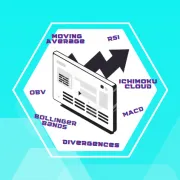What is a diversified portfolio? How to build a diversified portfolio? And how can a diversified portfolio improve your chances of reaching your financial goals? Creating and maintaining a diverse portfolio may seem like an overwhelming task. After all, the market has had some big ups and downs over the years. But knowing how to properly allocate assets can make your investment experience much more rewarding. The information in this article will help you understand what kinds of assets are needed in order to compose a well-balanced and effective portfolio.
Article summary
What is a diversified portfolio?
Spreading your investments so that you are not exposed to one type of asset for an extended period of time is known as diversification, and it is aimed at reducing the volatility of your portfolio over time.
One part of a portfolio that’s declining in value can hopefully be offset by another part that’s increasing in value. Though diversification does not ensure positive investment performance, it is widely used in investing to construct portfolios that can withstand changing economic conditions.
Advantages of building a diversified portfolio
- Impacts of market volatility are reduced
- Ensures the security of the capital
- Contributes to long-term investment plans
- Monitoring the portfolio requires less time
- Gives you peace of mind
Asset classes to use when building a diversified portfolio
The most important element of diversification is to find the right combination of asset classes that have the lowest possible correlation. For example, real estate will be hardly connected with crypto.
Here’s a non-exhaustive list of all potential asset classes you might want to consider:
Crypto
Think of using Vestinda as it enables you to automate your portfolio, greatly removing the human element that causes problems.
Equity
- in general markets. You can buy index funds like the Vanguard total market index fund which gives you a safe exposure to the full US stock market. Or you can bet on the entire world and buy an ETF like the one from iShares that tracks the investment results of an index composed of developed market equities. Or just hand pick your own basket of preferred stocks and ride the ones you believe in.
- in your own business. Being an entrepreneur and starting your own business is the best form of investment. That is because you own equity and, assuming your business succeeds, you could automate parts of it, allowing you to have forms of passive income.
Debt
- Bonds are used in most of the portfolios as the risk is low. It doesn’t come with a high return but can be vouched by governments or good companies that will most probably not default.
- Another way of investing in debt is P2P lending. You can consider platforms like Mintos in the traditional space or Nexo and Blockfi in the Crypto space. Our advice is to use regulated companies that have strict collateral rules in place and insurances.
Commodities
In this category, the most known investments are precious metals like gold, and silver. But there are a bunch of other subcategories to think of like energy or agriculture. It may come with more risk due to seasonality, or the storage of the commodities.
Real Estate
One of the most used category assets is also one that works best most of the time. It works during high inflation and can be used as a hedge to the more risky options. The drawdowns are low liquidity and a cost of maintenance (both in time and money).
Alternative assets like art and collectibles
This is one of the categories that gets more and more exposure in overall portfolios for the more sophisticated investors. The returns can be quite appealing; as more rich people want to own luxury or unique pieces. Similar to real estate, luxury pieces have lower liquidity so you need to account for that when giving this category a slice in your portfolio.
One can also diversify within the same asset class.
- You can do it on a national level. The mortgage market in the US is safer but less lucrative than the one in Venezuela.
- In Forex, you can buy major pairs like the EUR or GBP, but at the same time, get exposure to exotic, more volatile pairs like the Turkish lira or Russian Rouble.
If you don’t want to make them, you can instead look for other ways to make money work for you for you:
- You can angel invest in a business. That way, you let someone else take the risk of executing the idea and do the hard work.
- You can try to copy and automate investment strategies on platforms like Vestinda, that can help you find a profitable and consistent trader.
How to diversify your portfolio?
Once you have identified the assets you can, and want to have as part of your portfolio, you need to ask a very important question: “what is my risk profile?”
- Are you someone who likes taking high risks, and expecting high rewards? Do you like the idea of buying SHIB and seeing it rise 1,000%, at the risk of buying another coin that will drop 90%?
- Or, are you someone who’s more risk averse and is okay with a return that beats inflation and the indexes by a few basis points?
- Or, are you a conservative person who prefers to invest in tangible assets that you can see such as physical gold, or real estate?
Your profile can of course be a mix of all of these profiles, and there is no one set rule here. You need to identify what kind of investor you are, in order to allocate your capital. At the end of the day, no matter how many dollars you have, you still have to divide a pie worth 100%.
A risky investor might want to decide to put up to 80% of his capital in crypto, while a conservative might choose to be 50% in real estate, with 20% in bonds and interest rates, with the last 30% left for stock speculation and crypto investments.
To sum it up, there are 2 very important requirements to diversify your portfolio:
- Determine your risk profile
- Create an investment strategy that serves your profile best… and STICK to it. Don’t cheat and look around for new strategies when the price doesn’t go your way!
How to diversify a crypto portfolio?
In crypto, you can think of the coins as being divided into 6 categories:
- The most popular large caps that everyone knows like Bitcoin or Ethereum.
- Other famous layer 1 tokens that have existed for a while like Litecoin, Ripple or Monero. These are usually pre-ICO era.
- Newcomers largely propelled forward by the rise of DeFi such as AAVE, COMP, or LINK.
- The newer coins that flourished during the ICO (2017) and DEFI (2021) eras, but never materialized in real-world projects. These are usually highly volatile.
- You can also expose yourself to the highly volatile meme coins such as Doge or Shib.
- And last, but not least, the metaverse tokens that are gaining in popularity such as AXS or MANA.
In order to build your diversified portfolio, follow these steps:
- Decide how many buckets you will divide your cryptos in. You can use the 4 categories above for example. Note that it is also possible to divide them instead by sector or user case. Payments, Security, Governance, etc…
- Based on your risk profile, determine how much you will allocate to each of these buckets. A safer investment would focus on the big guys and old guard, while a riskier one would include more of the shit coins with massive upside potential.
- Decide on how often you will add to the portfolio. Will you add every other week, or once a month?
- Decide where you’ll store the coins, and how or when, if ever, will you take your profits.
When to consider portfolio rebalancing?
At the end of the day, the key to success in any investment strategy you employ is that you come up with your own investment strategy. Do the research yourself and study the options well so that you can come up with your own investment thesis and the best moment for rebalancing. A bespoke solution might be the wiser since it can be adapted to your own needs and risks profiles.
In order to maximize the profit and safety of your portfolio, it might be wise to look at other topics, for example:
- Global macro trends and macroeconomics can have a significant impact on your assets. COVID is such an important event that affected all asset classes at once creating chaos in some areas, but if you were smart enough, you could have turned this into a fantastic opportunity.
- Technological trends also play a massive role in the rise or fall of a portfolio’s assets. Crypto tokens are a prime example of an entire asset class capable of disrupting or bringing massive innovations to many areas of life. When smart contracts, for example, will reach mainstream usage, we will see a trove of new opportunities. NFT’s are such an example, but all other sorts of tokenized assets will change in life day to day, and thus, impact the price of assets that are directly correlated with the asset in question.
Keep these aspects in mind, and try to look for major news headlines, or hidden nuggets, that can point at a change in the wind for the progress of a certain industry or technology.
- For example, what are the potential repercussions of remote work on some tech stocks, or traditional retail stores, and thus of their price?
- What can be the future of semiconductors once the TSM bottleneck is resolved? And which stocks are capitalizing on it?
- How can you be part of the new cannabis boom?
- What new technologies that are now on the early adopters’ curve will change the world 15 years from now?
And on a final note, no matter what you decide when you ask yourself how to build a diversified portfolio, always remember the importance of having a strategy, and sticking to it.

Founder & CEO of Vestinda.
Compacting years of investment portfolio building into just a few minutes.







